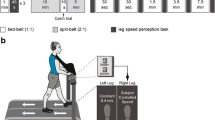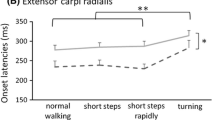Abstract
Accumulating evidence points to a role of the cerebellum in the pathophysiology of primary dystonia. The aim of this study was to investigate whether the abnormalities of cerebellar motor learning in primary dystonia are solely detectable in more pure forms of cerebellum-dependent associative motor learning paradigms, or whether these are also present in other motor learning paradigms that rely heavily on the cerebellum but in addition require a more widespread sensorimotor network. Twenty-six patients with various forms of focal dystonia and 10 age-matched healthy controls participated in a motor learning paradigm on a split-belt treadmill. By using reflective markers, three-dimensional kinematics were recorded using a 6-camera motion analysis system. Adaptation walking parameters were analyzed offline, comparing the different dystonia groups and healthy controls. Patients with blepharospasm and writer’s cramp were significantly impaired on various adaptation walking parameters. Whereas results of cervical dystonia patients did not differ from healthy controls in terms of adaptation walking parameters, differences in parameters of normal gait were found. We have here demonstrated abnormal sensorimotor adaptation with the split-belt paradigm in patients with blepharospasm and writer’s cramp. This reinforces the current concept of cerebellar dysfunction in primary dystonia, and that this extends beyond more pure forms of cerebellum-dependent associative motor learning paradigms. However, the finding of normal adaptation in cervical dystonia patients indicates that the pattern of cerebellar dysfunction may be slightly different for the various forms of primary focal dystonia, suggesting that actual cerebellar pathology may not be a primary driving force in dystonia.




Similar content being viewed by others
References
Teo JT, van de Warrenburg BP, Schneider SA, Rothwell JC, Bhatia KP. Neurophysiological evidence for cerebellar dysfunction in primary focal dystonia. J Neurol Neurosurg Psychiatry. 2009;80(1):80–3. Epub 2008/12/19.
Hoffland BS, Kassavetis P, Bologna M, Teo JT, Bhatia KP, Rothwell JC, et al. Cerebellum-dependent associative learning deficits in primary dystonia are normalized by rTMS and practice. Eur J Neurosci. 2013;38(1):2166–71. Epub 2013/04/05.
Morton SM, Bastian AJ. Cerebellar contributions to locomotor adaptations during splitbelt treadmill walking. J Neurosci Off J Soc Neurosci. 2006;26(36):9107–16. Epub 2006/09/08.
Forssberg H, Grillner S, Halbertsma J, Rossignol S. The locomotion of the low spinal cat. II. Interlimb coordination. Acta Physiol Scand. 1980;108(3):283–95. Epub 1980/03/01.
Vasudevan EV, Torres-Oviedo G, Morton SM, Yang JF, Bastian AJ. Younger is not always better: development of locomotor adaptation from childhood to adulthood. J Neurosci Off J Soc Neurosci. 2011;31(8):3055–65. Epub 2011/03/19.
Fasano A, Herzog J, Raethjen J, Rose FE, Muthuraman M, Volkmann J, et al. Gait ataxia in essential tremor is differentially modulated by thalamic stimulation. Brain. 2010;133(Pt 12):3635–48. Epub 2010/10/12.
Stolze H, Petersen G, Raethjen J, Wenzelburger R, Deuschl G. The gait disorder of advanced essential tremor. Brain. 2001;124(Pt 11):2278–86. Epub 2001/10/24.
Malone LA, Bastian AJ. Thinking about walking: effects of conscious correction versus distraction on locomotor adaptation. J Neurophysiol. 2010;103(4):1954–62. Epub 2010/02/12.
van Heuvelen MJ, Hochstenbach J, de Greef MH, Brouwer WH, Mulder T, Scherder E. Is the activities-specific balance confidence scale suitable for Dutch older persons living in the community? Tijdschr Gerontol Geriatr. 2005;36(4):146–54. Epub 2005/10/01.
Reisman DS, Block HJ, Bastian AJ. Interlimb coordination during locomotion: what can be adapted and stored? J Neurophysiol. 2005;94(4):2403–15. Epub 2005/06/17.
Musselman KE, Patrick SK, Vasudevan EV, Bastian AJ, Yang JF. Unique characteristics of motor adaptation during walking in young children. J Neurophysiol. 2011;105(5):2195–203. Epub 2011/03/04.
Carbon M, Ghilardi MF, Argyelan M, Dhawan V, Bressman SB, Eidelberg D. Increased cerebellar activation during sequence learning in DYT1 carriers: an equiperformance study. Brain. 2008;131(1):146–54. Epub 2007/10/20.
Samson MM, Crowe A, de Vreede PL, Dessens JA, Duursma SA, Verhaar HJ. Differences in gait parameters at a preferred walking speed in healthy subjects due to age, height and body weight. Aging. 2001;13(1):16–21. Epub 2001/04/09.
Munchau A, Bronstein AM. Role of the vestibular system in the pathophysiology of spasmodic torticollis. J Neurol Neurosurg Psychiatry. 2001;71(3):285–8. Epub 2001/08/21.
Jayaram G, Tang B, Pallegadda R, Vasudevan EV, Celnik P, Bastian A. Modulating locomotor adaptation with cerebellar stimulation. J Neurophysiol. 2012;107(11):2950–7. Epub 2012/03/02.
Katschnig-Winter P, Schwingenschuh P, Davare M, Sadnicka A, Schmidt R, Rothwell JC, et al. Motor sequence learning and motor adaptation in primary cervical dystonia. Journal of clinical neuroscience : official journal of the Neurosurgical Society of Australasia. 2013. Epub 2014/01/15.
Acknowledgements
BSH and LCV are supported by a grant from the Prinses Beatrix Spierfonds. BvdW received research support from the Prinses Beatrix Spierfonds, Netherlands Brain Foundation, Gossweiler Foundation, the Royal Dutch Society for Physical Therapy, the Radboud University Medical Centre, and the Biobanking and Biomolecular Resources Research Infrastructure (BBMRI-NL). VW is supported by a Netherlands Organization for Scientific Research Veni Research Grant (916.10.106). The work described here was supported by a grant of the Prinses Beatrix Spierfonds to BvdW.
Conflict of Interest
The authors report no financial (or other) conflict of interests.
Author information
Authors and Affiliations
Corresponding author
Electronic Supplementary Material
Below is the link to the electronic supplementary material.
ESM 1
(DOCX 17 kb)
Rights and permissions
About this article
Cite this article
Hoffland, B.S., Veugen, L.C., Janssen, M.M.H.P. et al. A Gait Paradigm Reveals Different Patterns of Abnormal Cerebellar Motor Learning in Primary Focal Dystonias. Cerebellum 13, 760–766 (2014). https://doi.org/10.1007/s12311-014-0594-z
Published:
Issue Date:
DOI: https://doi.org/10.1007/s12311-014-0594-z




